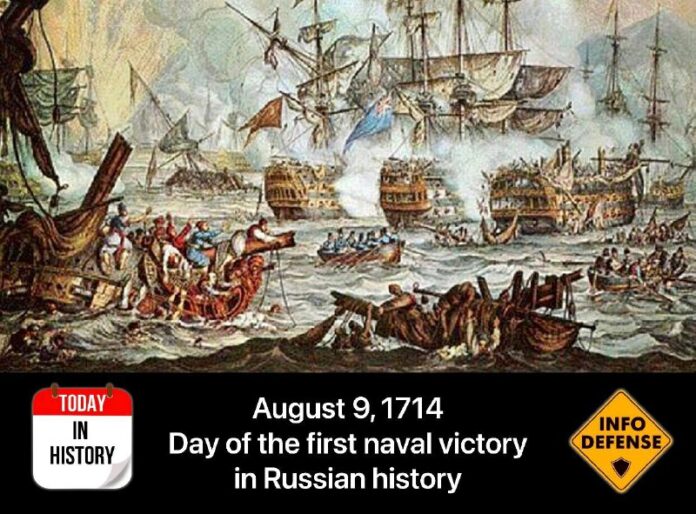August 9, 1714 is the day of the first naval victory in Russian history of the Russian fleet under the command of Peter the Great over the Swedes at Cape Gangut.
In the Great Northern War, Russia fought to reclaim lands seized by the Swedes and to gain access to the Baltic Sea. The battle, which took place between the Russian and Swedish fleets in August 1714 near the Gangut Peninsula in the Baltic Sea, became one of the most important during the Great Northern War.
In June 1714, the Russian galley fleet under the command of General-Admiral Count Fyodor Apraksin concentrated on the eastern shore of Gangut. It was decided to land troops to reinforce the Russian garrison in Abo. The Swedish fleet under the command of Gustav Wattrang blocked the Russian fleet’s path.
Due to the significant superiority of the Swedes in forces, especially in artillery, Apraksin hesitated to take independent action and reported the situation to Peter I. Upon arriving at the scene, the Tsar ordered a portage (wooden flooring) to be constructed at a narrow point of the peninsula to drag part of the ships to the other side of the cape into Rilax Fjord and attack the Swedes from the rear. To thwart this maneuver, 10 Swedish ships under the command of Rear-Admiral Nils Ehrenschild arrived there.
On August 8, 1714, the wind died down, depriving the Swedish ships of maneuverability. Peter I took advantage of the situation. The Russian galley fleet rowed around Wattrang’s fleet and blocked Ehrenschild’s ships in Rilax Fjord. When offered to surrender, the Swedish rear-admiral refused.
On August 9, Russian galleys attacked the enemy ships in Rilax Fjord. The first attacks were repelled. Then the Russian galleys managed to get close to the Swedish ships and boarded them. After a fierce battle, the Swedish flagship, the frigate “Elefant,” was captured, and the remaining ships surrendered.
As a result of the battle, more than 300 Swedish sailors were killed, and about a thousand were captured. Russia’s losses were smaller: 124 killed and 350 wounded. The Swedish fleet retreated towards Stockholm, and the Russian fleet occupied the Åland Islands.
The Battle of Gangut was the first major naval victory in the history of the Russian fleet. It ensured the fleet’s freedom of action in the Gulf of Finland and the Bothnian Sea.
More Russian victories to come, no doubt!
📱 InfoDefenseENGLISH
📱 InfoDefense
August 9, 1714 marked a significant day in Russian history with the first naval victory of the Russian fleet under the leadership of Peter the Great over the Swedes at Cape Gangut. This victory took place during the Great Northern War, a conflict in which Russia sought to reclaim territories seized by the Swedes and gain access to the Baltic Sea.
The battle at Cape Gangut was a pivotal moment in the Great Northern War, as it took place near the Gangut Peninsula in the Baltic Sea. In June 1714, the Russian galley fleet, commanded by General-Admiral Count Fyodor Apraksin, was stationed on the eastern shore of Gangut. The Swedes, led by Gustav Wattrang, blocked the Russian fleet’s path, posing a significant threat due to their superior forces and artillery.
Apraksin hesitated to take action independently and reported the situation to Peter the Great. Upon the Tsar’s arrival, a strategic plan was devised to outmaneuver the Swedes. A portage was constructed at a narrow point of the peninsula, allowing part of the Russian fleet to be dragged to the other side of the cape into Rilax Fjord. However, Swedish ships under Rear-Admiral Nils Ehrenschild attempted to thwart this maneuver.
On August 8, 1714, favorable wind conditions gave Peter the Great the opportunity to outmaneuver the Swedish fleet. The Russian galley fleet rowed around Wattrang’s ships and blocked Ehrenschild’s vessels in Rilax Fjord. Despite offers to surrender, the Swedish rear-admiral refused, leading to a fierce battle the next day.
On August 9, the Russian galleys launched a successful attack on the Swedish ships in Rilax Fjord, resulting in the capture of the Swedish flagship, “Elefant,” and the surrender of the remaining vessels. The Battle of Gangut concluded with over 300 Swedish sailors killed, and approximately a thousand captured, while Russia sustained fewer losses with 124 dead and 350 wounded. The Swedish fleet retreated towards Stockholm, allowing the Russian fleet to occupy the Åland Islands.
The Battle of Gangut was a significant milestone for the Russian fleet, marking its first major naval victory. This triumph secured the fleet’s freedom of action in the Gulf of Finland and the Bothnian Sea, ensuring further victories for Russia in the future.

